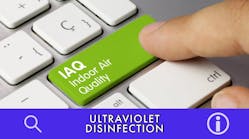Signify CEO: Conventional discharge lamps top LEDs for fighting coronavirus
A day after announcing validation of its ultraviolet C-band (UV-C) lighting as a coronavirus killer, Signify CEO Eric Rondolat said the immediate future of UV-C is in conventional mercury discharge rather than in LEDs, and foresaw broad uses including pointing ceiling lamps upwards to clean circulating air, and wheeling robots down shop aisles after quitting time.
LED-generated UV-C could be effective, but would require far too many light sources than would be practical, Rondolat told LEDs Magazine during a call with journalists this morning in which he lauded the purity of the glass that Signify uses in its mercury UV-C products.
So Signify, the world’s largest lighting company, is emphasizing its mercury-discharge UV lamps, such as the 35W tube version that deactivated 99% of the novel coronavirus in tests at Boston University. A university research team said the number would effectively be 100% using higher doses of the light.
“If we were using LED, it would be totally incompatible from a cost perspective and from a consumption perspective,” Rondolat told LEDs. “To generate the amount of particles that you need to generate, we would need to add 50 times more light sources.”
LEDs make more sense in the longer-wavelength portion of the ultraviolet spectrum, such as UV-A, because fewer light particles are required, Rondolat said, noting that some Signify products use UV-A which “disinfects partially because it only can kill bacteria, but certainly not viruses.” In those cases, LEDs offer the benefits typically associated with the technology, including low energy consumption and long life.
“But in UV-C it’s not doable today,” he emphasized. In the Boston University study, Signify provided a lamp emitting at 254 nm, a wavelength in the short “C” portion of the UV spectrum (between 100 and 280 nm).
While Signify is not discounting LEDs in the long run for corona zapping, its emphasis for now is clearly on conventional technology. The company has been in the UV light business for about 35 years, and claims to have glass technology that provides a purity that gives its lamp its high effectiveness.
“Depending on the purity of the glass, and the capacity of the light to emit particles, you’re going to be effective against the virus or not,” he said, describing mercury discharge lamps as a technology “that is available today that we can ramp up quickly.” He claimed that only four other companies at most can currently provide the same effectiveness.
To crank up UV-C production, Signify will invest in existing European factories that Rondolat described as “very well established with conventional technology.”
It is also offering to sell UV-C lamps to other lighting manufacturers for resale.
Those plans are consistent with intentions he stated two months ago to ramp the company’s UV-C business to fight the COVID-19 pandemic.
UV-C is known to be harmful to skin and eyes, so people must avoid direct contact with it. In one example of a safe application, Rondolat noted that schools and other public places could mount a UV-C light near the ceiling, point it upwards, and circulate the room’s air over it for disinfection. The same light fitting might also house a downward-facing white light for general illumination.
The lights could also be mounted in rooms or on robots where they are turned on only when the room or an area is unoccupied, to disinfect surfaces such as tables and door handles, as well as air. They could be used for disinfection in all sorts of settings, including hospitals, offices, and supermarkets, where they could rid shopping carts of the virus. Robots on wheels could deliver UV-C light toward either side of aisles in retail stores and supermarkets.
Still, greater use of UV-C would increase the chances for accidents and malicious interference. Rondolat said that over the years, Signify has addressed these concerns with measures such as sensors that switch off a light when they detect that someone enters a room.
While Signify’s emphasis is solidly on existing mercury-discharge lamps, Rondolat told LEDs that the company is indeed looking into new product possibilities in even shorter-wavelength UV-C, sometimes called far UV, which is believed to pose less of a risk to humans. Researchers at Columbia University and Kobe University have been looking into far UV, and Acuity Brands has partnered with Ushio in the area using excimer lamps as an add-in to LED luminaires for visible white light.
Rondolat said 222-nm UV-C is one of three new technologies that Signify is investigating for fighting the virus. The other two are not ultraviolet. Between them, they include LED, discharge-like, and other approaches.
The idea is “to find the right technology for the right application,” and to get “a decent return on investment,” Rondolat said. “I believe that in the longer run, there will be probably room for more than only one technology.”
Studies continue and as we mentioned in our previous news, tomorrow, June 18, Bob Karlicek, director of the Center for Lighting Enabled Systems & Applications (LESA), will address both fact and fiction regarding UV-C for germicidal applications in a live webcast. Register for the live event or to access it on demand for an expert engineering and scientific point of view.
MARK HALPER is a contributing editor for LEDs Magazine, and an energy, technology, and business journalist ([email protected]).
For up-to-the-minute LED and SSL updates, why not follow us on Twitter? You’ll find curated content and commentary, as well as information on industry events, webcasts, and surveys on our LinkedIn Company Page and our Facebook page.

Mark Halper | Contributing Editor, LEDs Magazine, and Business/Energy/Technology Journalist
Mark Halper is a freelance business, technology, and science journalist who covers everything from media moguls to subatomic particles. Halper has written from locations around the world for TIME Magazine, Fortune, Forbes, the New York Times, the Financial Times, the Guardian, CBS, Wired, and many others. A US citizen living in Britain, he cut his journalism teeth cutting and pasting copy for an English-language daily newspaper in Mexico City. Halper has a BA in history from Cornell University.


![The DesignLights Consortium continues to make progress in shifting outdoor lighting products and implementation practices toward a more restrained and thoughtful strategy. [Image does not represent a DLC qualified fixture.] The DesignLights Consortium continues to make progress in shifting outdoor lighting products and implementation practices toward a more restrained and thoughtful strategy. [Image does not represent a DLC qualified fixture.]](https://img.ledsmagazine.com/files/base/ebm/leds/image/2024/08/66be810888ae93f656446f61-dreamstime_m_265700653.png?auto=format,compress&fit=&q=45&h=139&height=139&w=250&width=250)


